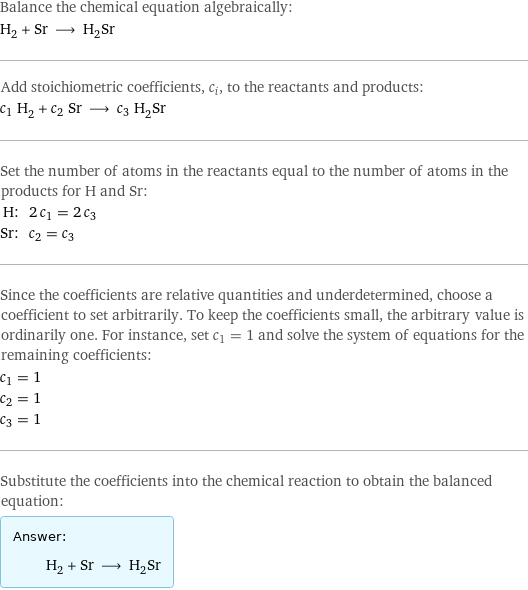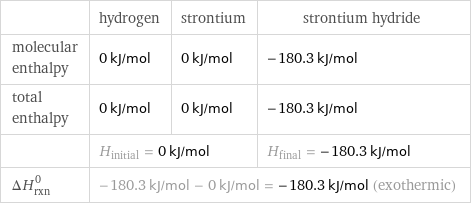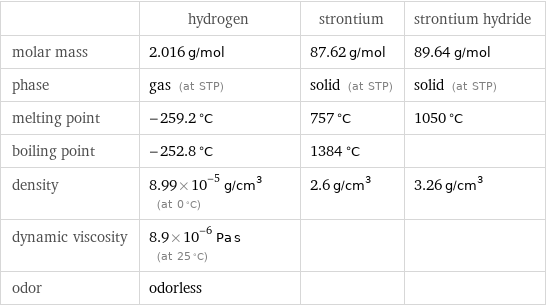Input interpretation

H_2 hydrogen + Sr strontium ⟶ H_2Sr strontium hydride
Balanced equation

Balance the chemical equation algebraically: H_2 + Sr ⟶ H_2Sr Add stoichiometric coefficients, c_i, to the reactants and products: c_1 H_2 + c_2 Sr ⟶ c_3 H_2Sr Set the number of atoms in the reactants equal to the number of atoms in the products for H and Sr: H: | 2 c_1 = 2 c_3 Sr: | c_2 = c_3 Since the coefficients are relative quantities and underdetermined, choose a coefficient to set arbitrarily. To keep the coefficients small, the arbitrary value is ordinarily one. For instance, set c_1 = 1 and solve the system of equations for the remaining coefficients: c_1 = 1 c_2 = 1 c_3 = 1 Substitute the coefficients into the chemical reaction to obtain the balanced equation: Answer: | | H_2 + Sr ⟶ H_2Sr
Structures

+ ⟶
Names

hydrogen + strontium ⟶ strontium hydride
Reaction thermodynamics
Enthalpy

| hydrogen | strontium | strontium hydride molecular enthalpy | 0 kJ/mol | 0 kJ/mol | -180.3 kJ/mol total enthalpy | 0 kJ/mol | 0 kJ/mol | -180.3 kJ/mol | H_initial = 0 kJ/mol | | H_final = -180.3 kJ/mol ΔH_rxn^0 | -180.3 kJ/mol - 0 kJ/mol = -180.3 kJ/mol (exothermic) | |
Equilibrium constant
![Construct the equilibrium constant, K, expression for: H_2 + Sr ⟶ H_2Sr Plan: • Balance the chemical equation. • Determine the stoichiometric numbers. • Assemble the activity expression for each chemical species. • Use the activity expressions to build the equilibrium constant expression. Write the balanced chemical equation: H_2 + Sr ⟶ H_2Sr Assign stoichiometric numbers, ν_i, using the stoichiometric coefficients, c_i, from the balanced chemical equation in the following manner: ν_i = -c_i for reactants and ν_i = c_i for products: chemical species | c_i | ν_i H_2 | 1 | -1 Sr | 1 | -1 H_2Sr | 1 | 1 Assemble the activity expressions accounting for the state of matter and ν_i: chemical species | c_i | ν_i | activity expression H_2 | 1 | -1 | ([H2])^(-1) Sr | 1 | -1 | ([Sr])^(-1) H_2Sr | 1 | 1 | [H2Sr] The equilibrium constant symbol in the concentration basis is: K_c Mulitply the activity expressions to arrive at the K_c expression: Answer: | | K_c = ([H2])^(-1) ([Sr])^(-1) [H2Sr] = ([H2Sr])/([H2] [Sr])](../image_source/cbb48b4e67e6a5e1e2e83cda102f7271.png)
Construct the equilibrium constant, K, expression for: H_2 + Sr ⟶ H_2Sr Plan: • Balance the chemical equation. • Determine the stoichiometric numbers. • Assemble the activity expression for each chemical species. • Use the activity expressions to build the equilibrium constant expression. Write the balanced chemical equation: H_2 + Sr ⟶ H_2Sr Assign stoichiometric numbers, ν_i, using the stoichiometric coefficients, c_i, from the balanced chemical equation in the following manner: ν_i = -c_i for reactants and ν_i = c_i for products: chemical species | c_i | ν_i H_2 | 1 | -1 Sr | 1 | -1 H_2Sr | 1 | 1 Assemble the activity expressions accounting for the state of matter and ν_i: chemical species | c_i | ν_i | activity expression H_2 | 1 | -1 | ([H2])^(-1) Sr | 1 | -1 | ([Sr])^(-1) H_2Sr | 1 | 1 | [H2Sr] The equilibrium constant symbol in the concentration basis is: K_c Mulitply the activity expressions to arrive at the K_c expression: Answer: | | K_c = ([H2])^(-1) ([Sr])^(-1) [H2Sr] = ([H2Sr])/([H2] [Sr])
Rate of reaction
![Construct the rate of reaction expression for: H_2 + Sr ⟶ H_2Sr Plan: • Balance the chemical equation. • Determine the stoichiometric numbers. • Assemble the rate term for each chemical species. • Write the rate of reaction expression. Write the balanced chemical equation: H_2 + Sr ⟶ H_2Sr Assign stoichiometric numbers, ν_i, using the stoichiometric coefficients, c_i, from the balanced chemical equation in the following manner: ν_i = -c_i for reactants and ν_i = c_i for products: chemical species | c_i | ν_i H_2 | 1 | -1 Sr | 1 | -1 H_2Sr | 1 | 1 The rate term for each chemical species, B_i, is 1/ν_i(Δ[B_i])/(Δt) where [B_i] is the amount concentration and t is time: chemical species | c_i | ν_i | rate term H_2 | 1 | -1 | -(Δ[H2])/(Δt) Sr | 1 | -1 | -(Δ[Sr])/(Δt) H_2Sr | 1 | 1 | (Δ[H2Sr])/(Δt) (for infinitesimal rate of change, replace Δ with d) Set the rate terms equal to each other to arrive at the rate expression: Answer: | | rate = -(Δ[H2])/(Δt) = -(Δ[Sr])/(Δt) = (Δ[H2Sr])/(Δt) (assuming constant volume and no accumulation of intermediates or side products)](../image_source/108f5baaffa516b6e9641e02035e5254.png)
Construct the rate of reaction expression for: H_2 + Sr ⟶ H_2Sr Plan: • Balance the chemical equation. • Determine the stoichiometric numbers. • Assemble the rate term for each chemical species. • Write the rate of reaction expression. Write the balanced chemical equation: H_2 + Sr ⟶ H_2Sr Assign stoichiometric numbers, ν_i, using the stoichiometric coefficients, c_i, from the balanced chemical equation in the following manner: ν_i = -c_i for reactants and ν_i = c_i for products: chemical species | c_i | ν_i H_2 | 1 | -1 Sr | 1 | -1 H_2Sr | 1 | 1 The rate term for each chemical species, B_i, is 1/ν_i(Δ[B_i])/(Δt) where [B_i] is the amount concentration and t is time: chemical species | c_i | ν_i | rate term H_2 | 1 | -1 | -(Δ[H2])/(Δt) Sr | 1 | -1 | -(Δ[Sr])/(Δt) H_2Sr | 1 | 1 | (Δ[H2Sr])/(Δt) (for infinitesimal rate of change, replace Δ with d) Set the rate terms equal to each other to arrive at the rate expression: Answer: | | rate = -(Δ[H2])/(Δt) = -(Δ[Sr])/(Δt) = (Δ[H2Sr])/(Δt) (assuming constant volume and no accumulation of intermediates or side products)
Chemical names and formulas

| hydrogen | strontium | strontium hydride formula | H_2 | Sr | H_2Sr name | hydrogen | strontium | strontium hydride IUPAC name | molecular hydrogen | strontium | hydrogen(-1) anion; strontium(+2) cation
Substance properties

| hydrogen | strontium | strontium hydride molar mass | 2.016 g/mol | 87.62 g/mol | 89.64 g/mol phase | gas (at STP) | solid (at STP) | solid (at STP) melting point | -259.2 °C | 757 °C | 1050 °C boiling point | -252.8 °C | 1384 °C | density | 8.99×10^-5 g/cm^3 (at 0 °C) | 2.6 g/cm^3 | 3.26 g/cm^3 dynamic viscosity | 8.9×10^-6 Pa s (at 25 °C) | | odor | odorless | |
Units
